




| Home | Features | Club Nights | Underwater Pics | Feedback | Non-Celebrity Diver | Events | 26 April 2024 |
| Blog | Archive | Medical FAQs | Competitions | Travel Offers | The Crew | Contact Us | MDC | LDC |

|

|
 
 |
 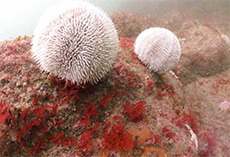 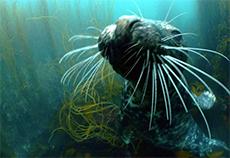 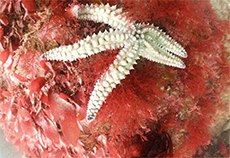 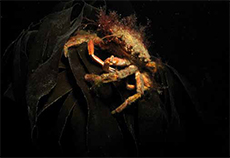 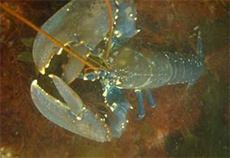 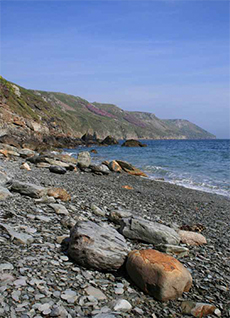 ISSUE 17 ARCHIVE - THE SEA DOC INVESTIGATES: LUNDY ISLANDDr John CarlinWhat Connects Tom Cruise to Lundy Island?I don’t think it’s presumptuous to assume that most Tanked Up read- ers will have heard of the actor Tom Cruise who starred in movie blockbusters such as ‘Minority Report’, ‘Mission Impossible’ and, of course, ‘Top Gun’, which is argu- ably one of the greatest films of all time. But how many people have heard of a magical place called Lundy Island? Imagine a tiny island only 5 kilometres long by 1.25 kilome- tres wide which has been inhabited for over 3,000 years. Its history tells tales of pirates and shipwrecks, kings and the Knights Templar. Its landscape is a rich tapestry of grassy fields, steep cliffs, dark caves, exotic and endan- gered plants, birds and animals. The sheer cliffs drop off into an underwater realm full of such colours, beauty and creatures that will take your breath away. It’s a magical place of peace and tranquillity that could exist in a child’s fairy tale, but luckily for us, it is real and is right on our doorstep. Lundy Island is the largest island in the Bristol Channel and this 141 metre high granite outcrop is the only thing to stand between us and America. The name is thought to be derived from the old Norse word ‘Lundey’ meaning ‘Puffin Island’. It is an old volcanic island made of 93% granite and 7% shale. The granite used to be quarried and both the Charing Cross Hotel and the Victoria Embank- ment in London were built from Lundy granite. People have been living on Lundy Island for over 3,000 years. Three prehistoric settlements have been found on the island with evidence of tools, pots, beads, huts and gravestones. So who actually owns Lundy? The Knights Templar, an order of soldiers officially en- dorsed by the Catholic Church and who are associated with legends concerning secrets and mysteries, were granted the island by King Henry II in 1160. It is thought that they were given control of the island, as at the time the Templars were a major maritime force and King Henry II thought they may offer protection from the increasing threats of Viking attacks. It is unclear if the Knights Templar ever took possession of the island but there is a rock formation bearing their name, called Templars Rock, which is said to resemble one of the religious men of the crusading days. However the ownership of the island was disputed by the Marisco family who claimed that Lundy Island had been given to them by way of a fief (a fee for their loyalty) by King Stephen. King Henry II tried to force the Mariscos off the island by fining them and cutting off necessary sup- plies. The lack of interest from the Knights Templar was confirmed when King John in 1199, confirmed the Mari- scos earlier grant of ownership of Lundy Island. The Marisco family fell out of Royal favour when a William de Marisco was implicated in the murder of Henry Clement, a messenger for King Henry III, which was made worse following an attempt to kill King Henry III, by a man who later confessed to be an agent for the Mariscos. William de Marisco was reportedly a pirate, who, with a band of loyal followers attacked and plundered ships in the Bristol Channel and committed robberies along the Devon coastline. In response to this in 1242, King Henry III sent his troops to the island who captured William and sixteen of his men. William was then convicted of treason and became one of the first men to be hung, drawn and quartered. King Henry III tried to establish law and order on the is- land by building a castle which is now ironically referred to as the Marisco Castle, but Lundy proved hard to govern. English and foreign pirates used Lundy as a base to prey on vulnerable merchant ships loaded with valuable goods from overseas. There are records of pirates using it to leave crews of the boats they captured on the island to ‘perish of hunger’. Another interesting Lundy owner was Thomas Benson, a famous smuggler who, after inheriting a large family for- tune, became the Sheriff of Devon and the MP for Barn- staple. In 1747 he leased Lundy Island and used this as a base to hide his smuggled goods such as tobacco, as well as unloading convicts to use as personal slaves who he was meant to be transporting to America. Lundy Island is sometimes referred to as the ‘Kingdom of Heaven’. This name comes from William Hudson Heaven who purchased Lundy Island at a cost of 9,400 guineas (just under £10,000 in today’s money) as a summer retreat. The most beautiful building on the island is St. Helen’s church which was built and completed in 1896 by William Heaven’s son, the Reverend Hudson Grosset Heaven and acts as a lasting memorial to the Heaven family. The final family to privately own the island were the Harmans. Martin Coles Harman bought Lundy in 1924 and proclaimed himself a king. Well I would, wouldn’t you if you owned an island? Martin fought for years to obtain recognition that his ‘kingdom’ was outside the jurisdiction of the British Parliament. He even minted his own ‘Puffin Coins’ and ‘Puffin Stamps’. Lundy Island was passed through the family to his son Albi- on and his daughters, Ruth and Diana. Albion Harman loved Lundy and tried to spend as much of his free time there as he could. He tried to establish the island as a holiday resort and a centre for the study of wildlife. So come on, how is Tom Cruise connected to Lundy Island? In 1968, Albion passed away and in 1969 Lundy Island was put up for sale as the Harman family found the death duties and restrictions too much to deal with. A public auction in Barnstaple was announced. A controversial modern religious movement called the Church of Scientology (who now count Tom Cruise as a member) put in a bid for Lundy Island with the intention to use the island for a social experiment. According to a Mr D.B. Gaiman, a spokesman for Scientologists, they intended to use Lundy “as a place for sanctuary or retreat for people who are disturbed but not insane and who might otherwise be locked up in mental hospitals”. The National Trust expressed an interest in Lundy Island but did not have the funds to place a bid, so it was with great re- lief that a British millionaire called Jack Hayward stepped in. Jack Hayward is an English business man, property develop- er and philanthropist who now resides in the Bahamas and is the life president of the Wolverhamton Wanderers football club. He bought Lundy Island and gave it to the National Trust, who then leased it to the Landmark Trust. The Landmark Trust now manages the island getting money from donations, organising day trips and letting out holiday accommodation. I have been lucky enough to stay twice on the island with friends at a place called Millcombe House (also known as ‘The Villa’) which was built in the ‘Heaven’ period. Millcombe House sits on the East Coast of the island halfway up the hillside, giving amazing views of Landing Bay, and just below the Marisco Tavern, the only pub on the island. Lundy Island averages 20,000 day trip visitors a year. Get- ting to Lundy is part of the adventure. To get across you leave your car on the mainland and come across either on the MS Oldenburg (the supply ship), by charter boat or by helicopter if the weather is too rough to sail. Visitors come to see the cliffs and hanging valleys rich in wildlife and wildflowers. Whenever I visit Lundy I feel the magic of the place and I feel a sense of peace as soon as I take my first footstep on the island. It is a world apart, where you can walk on top of the island taking in the sights, breathing in the fresh air and watching the wheel- ing seabirds calling to each other. The second link between Lundy Island and Tom Cruise... Tom Cruise is an avid Scuba diver and the snorkelling and diving around Lundy Island is some of the best I have done ANYWHERE in the world. That is a quite a big statement and I am going to explain why... It is not just the granite island itself but the waters that sur- round Lundy Island which make it a place you must go and visit. The seabed around Lundy is owned by the Crown Estate with an area of the foreshore and seabed leased by English Nature for anchorage. Lundy offers remarkably good visibility when you go diving and this is because of its unique geographical position. It is 18 kilometres away from the nearest mainland which means it suffers very little from mainland pollution. The east and west coasts of Lundy are very different as the island itself acts as a huge natural breakwater where water flows from the south and west into the Bristol Channel. The west coast of the island braves the strong winds, severe gales and the powerful waves that come in from the Atlantic swell. This has had a direct effect on shaping the physical features and the flora and fauna found on the shore and the surrounding shallow sea bed. The currents around Lundy are fierce. As a diver, it is important to listen to the briefings from your boat skipper when boat diving or speak to the warden to get permission to shore dive and find out where limited entry points are. The currents are a result of the very strong tides within the Bristol Channel which mean the sea around Lundy can rise and fall by as much as 9 metres. That is massive! The strong currents and tides have helped to shape Lundy’s underwater world and you will find underwater cliffs, valleys, canyons, pinnacles, gullies, boulder slopes and even plains of mud, sand and gravel to go and explore. One of my favourite dive sites is called the Knoll Pins. A pair of large rocks or pinnacles that stick out at low tide, and at high tide, the kelp on top of the pins is visible from the surface. The pinnacles drop down to the seabed at 15-25 metres depending on the pinnacle and which side you are on. The vertical exposed walls are covered in cup corals, jewel anemones, dead man’s fingers and sponges. If you look closely in amongst the kelp you will find hiding dogfish, plus different types of crabs and lobsters. If you are lucky you may even spot a nudibranch. If you have ever watched ‘Blue Planet’, there is a chapter called ‘The Temperate Seas’, which talks about kelp for- ests. Kelp grows in shallow water by using root-like struc- tures called ‘holdfasts’ to grip onto rocky reefs, boulders and even substantial pieces of wreckage. The kelp forests around Lundy provide shelter for many plants and animals. You will see fish (especially wrasse) dart in amongst the fronds, edible urchins climbing up the trunk of the frond (known as the kelp stipe) with crabs and lobster crawling amongst the holdfasts. Gannets Bay is a great dive site to see the Lundy’s kelp forests and this is where, if you are lucky, you will also get to dive with seals. Lundy is home to a breeding colony of a hundred and twenty grey seals. The grey seal, also known as Atlantic seal, is one of the largest and rarest types of seal in the world. The seals get more used to divers throughout the summer and can become very playful. On both of my diving trips to Lundy I have had seals playing hide and seek in the kelp, chewing on my fin tips and then popping up alongside the boat as I exited the water. You can’t help but smile as they zip in and out so gracefully between you and your diving buddy. Other types of visitors to Lundy Island: Like Scuba divers there are other creatures who are at- tracted to Lundy during the summer months. The world’s second biggest fish, the basking shark, is an occasional visitor to Lundy along with sunfish (or Mola Mola) and even leatherback turtles. But are there any wrecks to dive I hear the metal heads ask? There certainly are. Over two hundred ships have met a watery demise due to Lundy’s treacherous coastline, strong currents and not infrequent Bristol Channel fogs. These ship wrecks provide an attraction for visiting Scuba divers and have become artificial reefs covered in marine life. One of my favourite wrecks is the M.V. Robert, which is Lundy’s only intact wreck. It was a 50 metre single screw coaster that capsized and sank in 1975 and now lies on the seabed at 25 metres on it’s starboard side. Hermit and swimming crabs, scallops, burrowing anemo- nes, conger eels and even the occasional John Dory can be seen on this dive. There is also the biggest lobster I have ever seen which calls the M.V. Robert its home. It’s claw was so big that it just dragged it along the sand and then barged me out of the way as it carried on with its day to day business. Britain’s first Marine Nature Reserve: The importance of Lundy Island as a marine bio-diversity hotspot was highlighted when the Lundy Field Society made a proposal to establish the island as a Marine Re- serve. In November 1986, Lundy Island was designated as Britain’s first statutory Marine Nature Reserve. It has also been selected by the European Union as a ‘Special Area of Conservation’ and these designations acknowl- edge that Lundy’s marine environment is very, very special. In 2003, an area about 4 kilometres square on the east side of the island was set up as a ‘No Take Zone’ (NTZ). It was the first of it’s kind in Britain and was created to try and reverse the problems caused by overfishing. An annual monitoring program began in 2004 to establish the effects of the NTZ and after just 18 months scientists discovered that there were three times as many lobsters in the NTZ compared to other areas where fishing is allowed. So Lundy Island is an ancient island rich in history, wildlife and beauty. This article cannot do it justice and so you are just going to have to go and visit it to find out why it is one of my favourite diving spots anywhere in the world. I am already starting to plan my next visit, are you? |